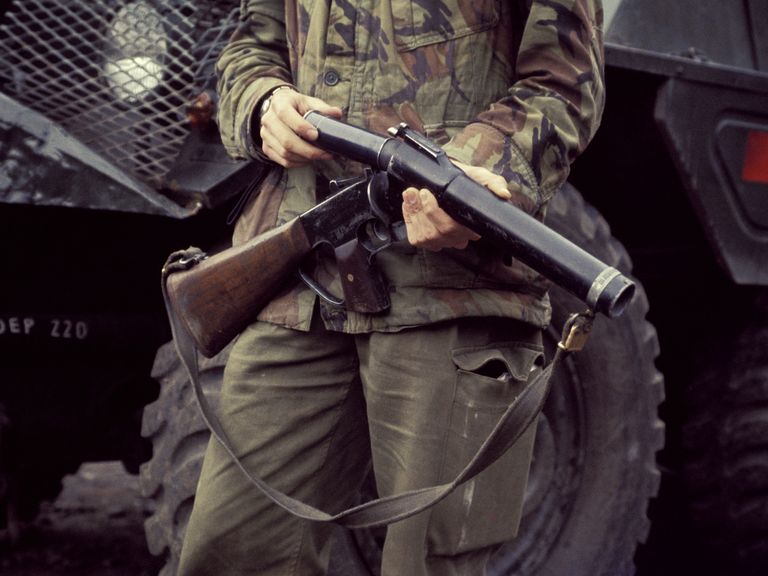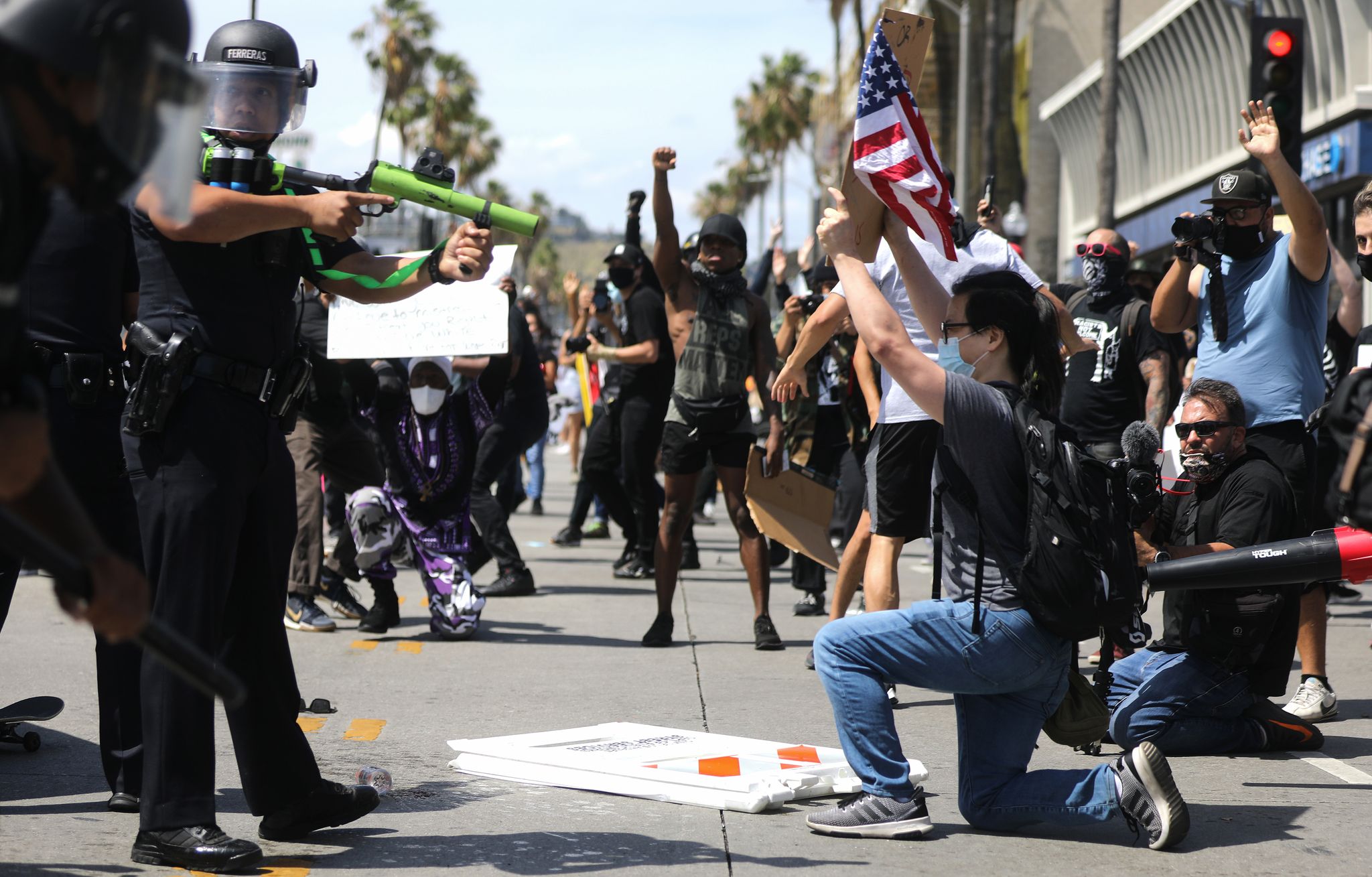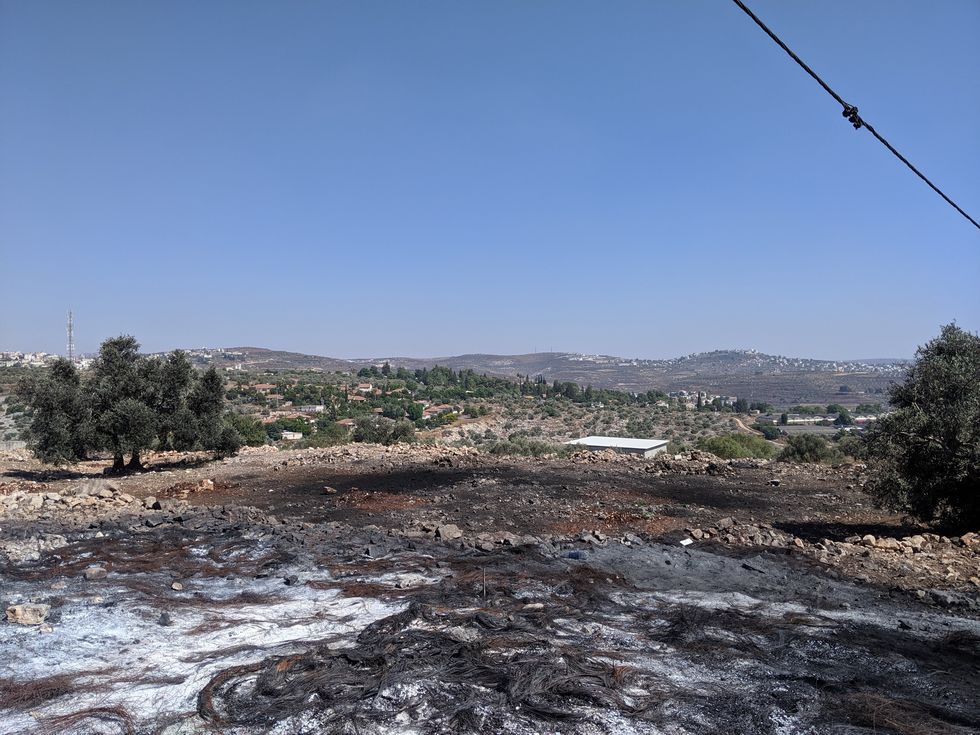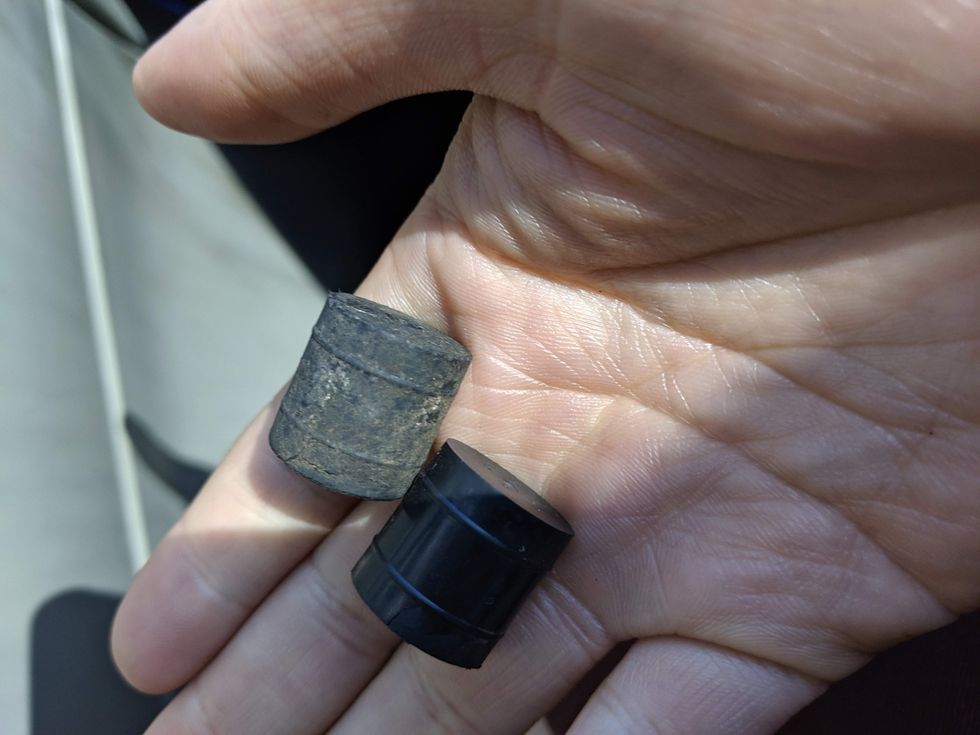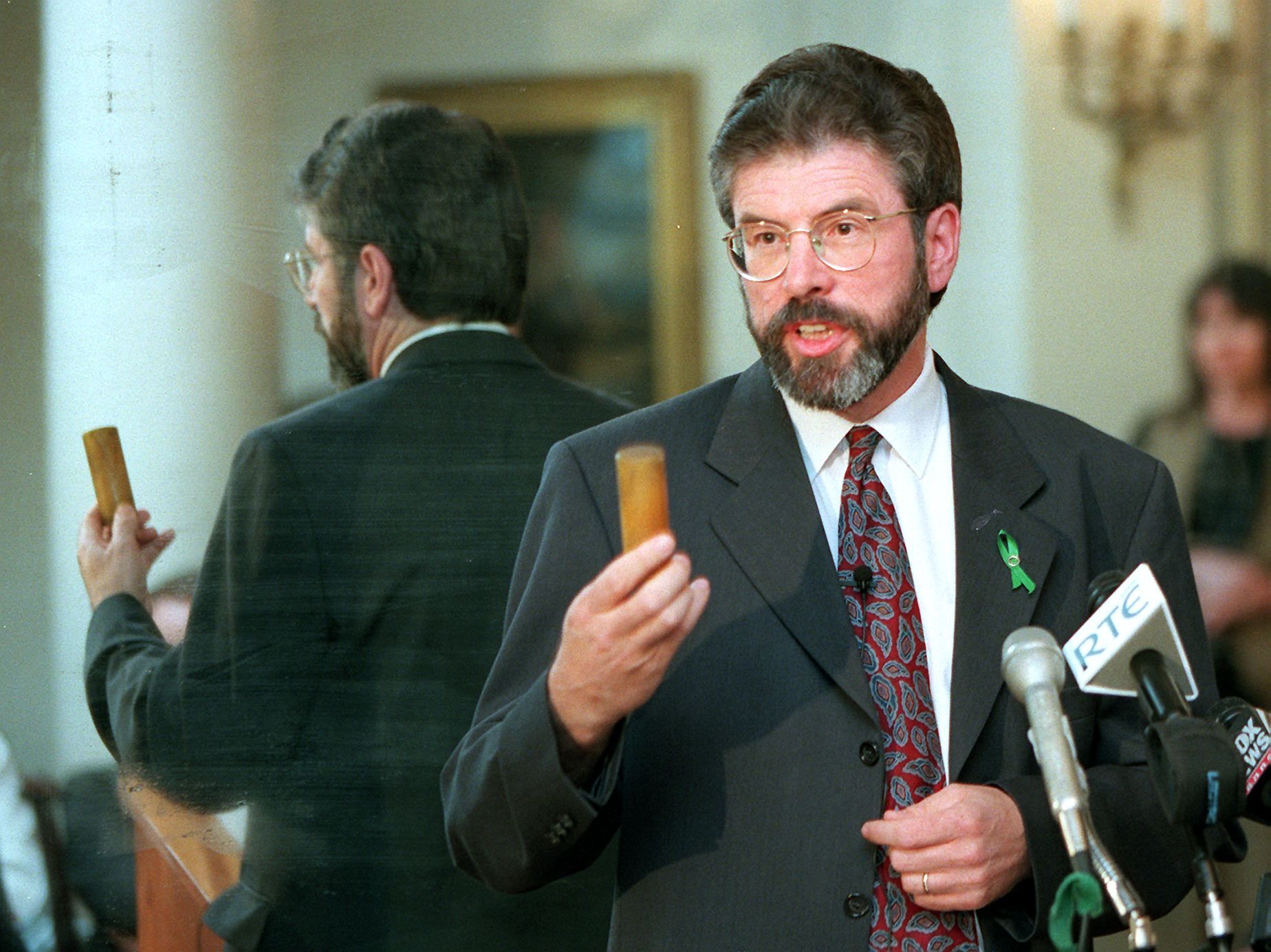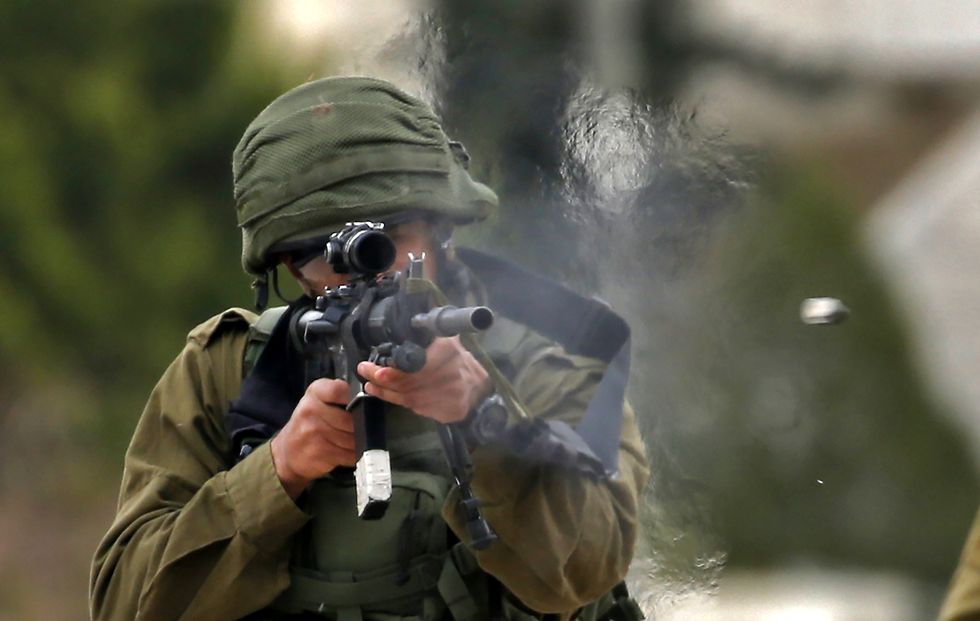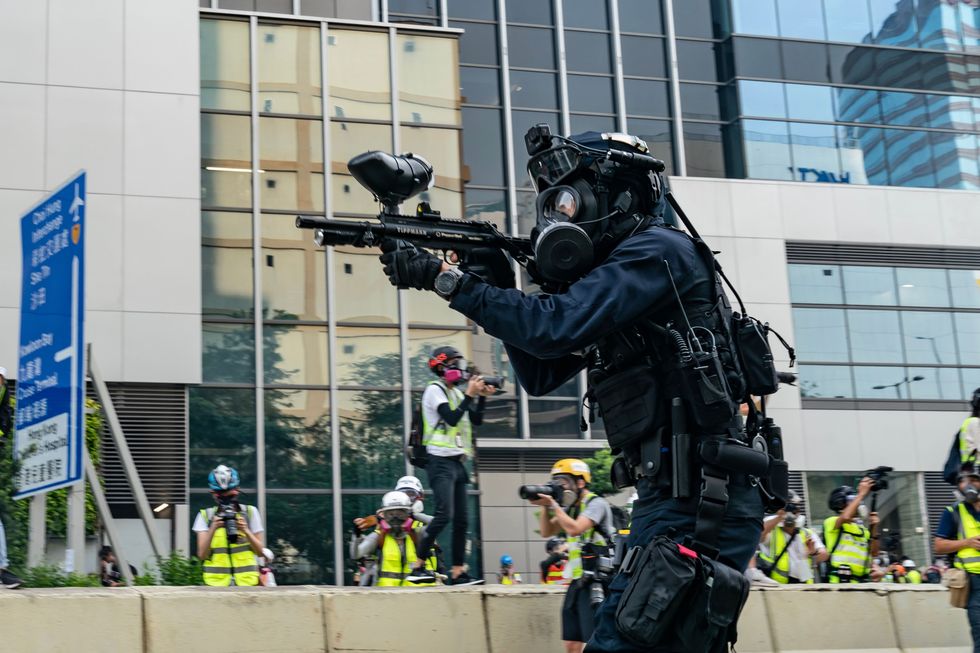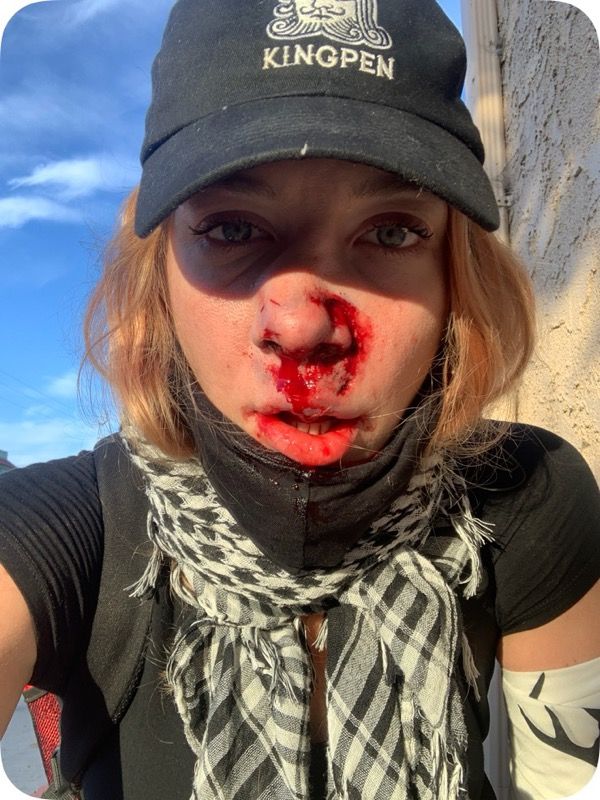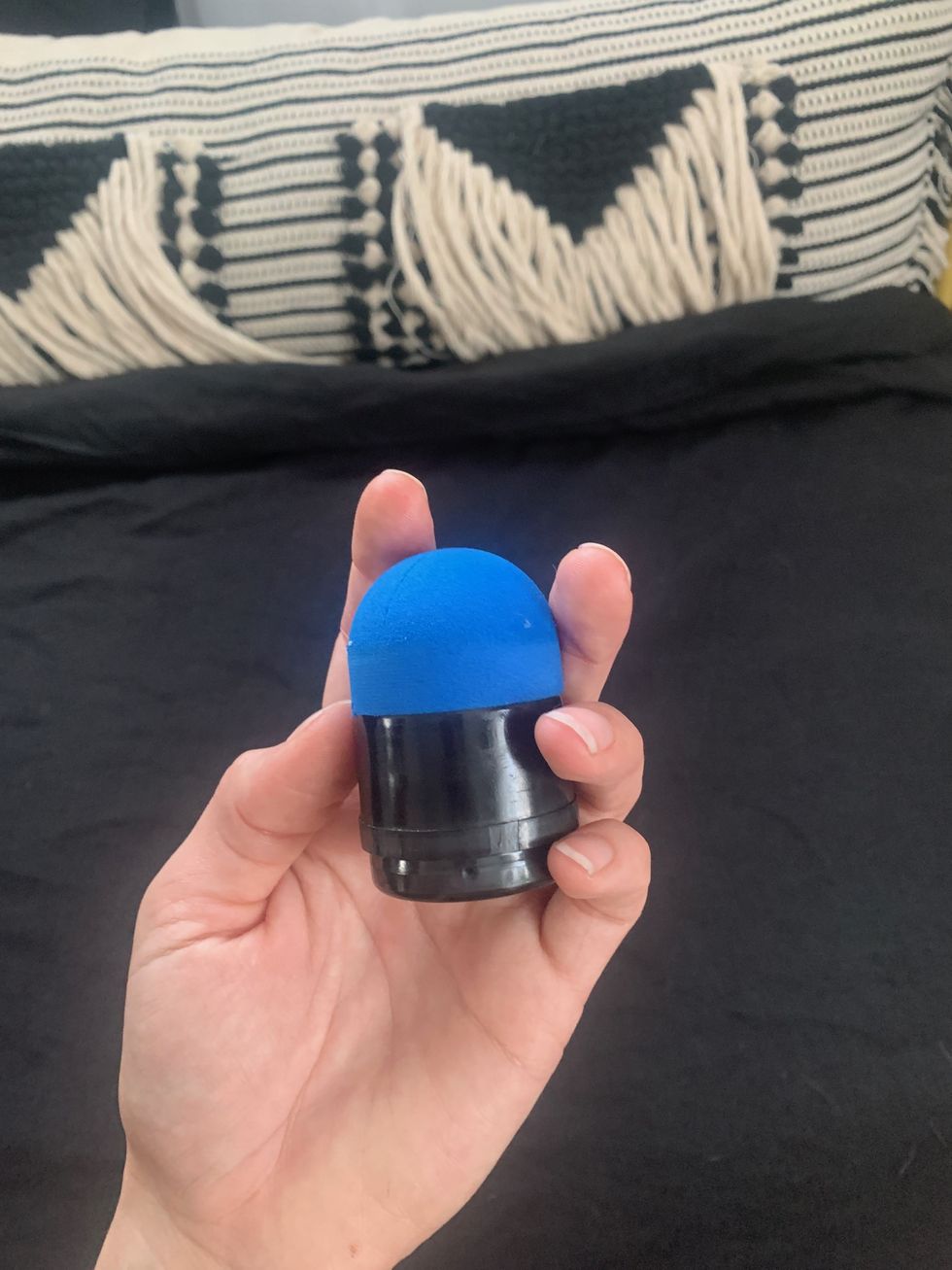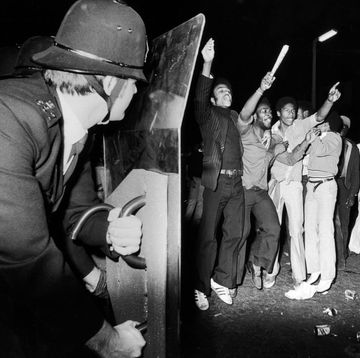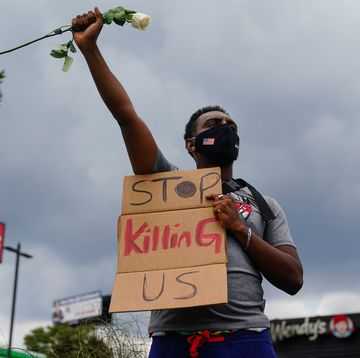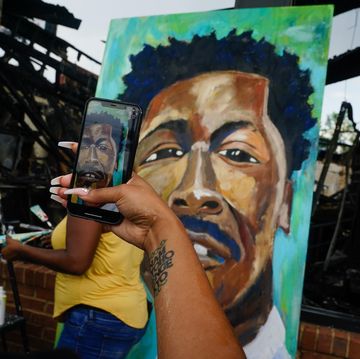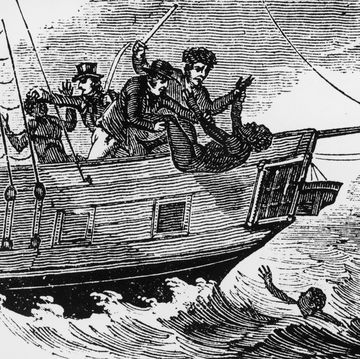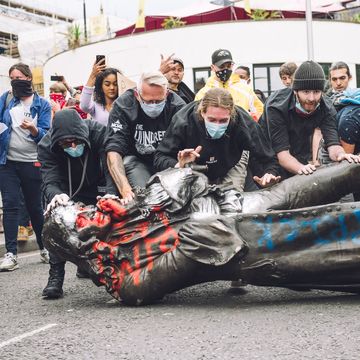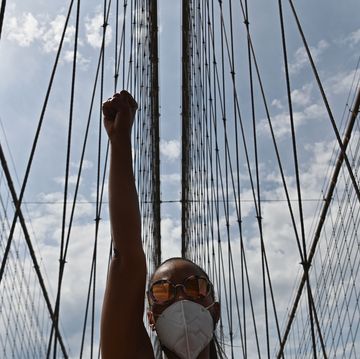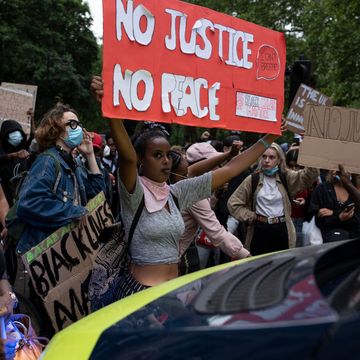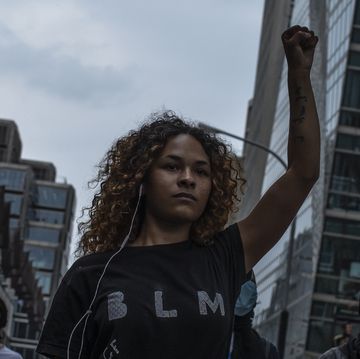On 6:45pm on 30 May, Trish Hill found herself in a crowd of protestors in central Los Angeles. Across from her stood a row of police officers, dressed in riot gear and armed with batons and rifles. Like those around her, Hill, a 31-year-old marijuana dispensary manager, had taken to the streets to protest a killing that had happened almost 2,000 miles away when, five days earlier in Minneapolis, an unarmed black man called George Floyd had been choked to death by Derek Chauvin, a white police officer. Despite the distance, Floyd’s death had opened old wounds in LA, a city scarred with incidents of police brutality against black men.
The protest, which had kicked off at 2pm, was growing chaotic by the time Hill showed up. “There was evidence of smoke bombs,” she tells me. All around she could see faces drenched in milk of magnesia to counter tear gas. Dumpsters had been set on fire and were being rolled towards the line of police officers.
Word was leaking out that the curfew – originally set at 8pm – had been pushed up to eight seven o'clock. Soon, the demonstration would be considered an unlawful gathering. Most protestors intended to stay put, but even those who wanted to leave struggled to get away, as the police had them surrounded. Then, on the hour, the line of cops started to move in.
The rifles that police officers lifted to their shoulders were designed to fire ‘non-lethal projectiles’ and they soon began thudding into the crowd. The day before Hill, who stands over six feet, had attended another protest where she'd been struck in the buttocks by a non-lethal projectile. It had hurt, but only left bruises, so she felt comfortable protecting others. “I decided that putting my body between [the police and] Black protesters would have the most effect because either I would not be hit, I would be hit in a lesser capacity, or I would have the means to cope with being hit a little bit more easily then perhaps some of my fellow protesters.”
She was wrong. Three minutes after curfew started, she was struck in the face. She is still unsure precisely what hit her – bodycam videos released by the LAPD show them firing beanbag rounds and rubber bullets – but she knew immediately that her nose had been broken, and took cover in a side street. Her scarf and mask, which she wore for Covid-19 protection, were drenched with blood. “Before this incident, I assumed rubber bullets were smaller – more like the size of paintballs. I also expected them to do the same amount of damage,” Hill says. “I was extraordinarily surprised not only to find a plastic component of the bullet that hit me but also just the sheer size of it. It was very shocking.”
A few days later in Dallas, Texas, a Black protestor, 26-year-old Brandon Saenz, was shot in the face while demonstrating near City Hall. Nearby, his friends found a foam pellet called a sponge round. The name carries a connotation of safety – something soft, protective, designed to prevent harm. But after being shot by one, Saez lost his left eye, several teeth, and requires multiple rounds of facial surgery.
The term ‘rubber bullet’ is misleading. It conjures up an image of something bouncy, like a squash ball – unpleasant enough to be struck with at high velocity, though unlikely to cause long-term damage. But rubber bullets are much more bullet than they are rubber.
My first-hand account with rubber bullets came last summer, on a trip with activists from across the globe to Israel/Palestine. (I’m a New Yorker with soft hands whose injuries include broken fingers from falling.) A representative from Machsom Watch, a local NGO led by retired women who monitor checkpoints between Israel and the Occupied Territories for human rights abuses, took 17 or so of us activists to different flashpoint areas. We were given a tour of a surprisingly lethargic rural checkpoint. We had lunch in Kfar Qaddum, a sleepy town in central West Bank where donkey-drawn carriages rode past as we ate. As with many cities in the West Bank, Gaza, and Arab-residing East Jerusalem, the residents held peaceful protests on Friday, often after Jumaah prayers. (The weekend is Friday-Saturday in the region.) After lunch, we were brought to the site of the protest, which was marked out by the remains of burned tyres, with wires sticking out of them.
I had read about this town in the previous week, when a ten-year-old boy sustained injuries from a non-lethal projectile. Abdul-Rahman Yasser Shteiwi was rushed to hospital and remained in critical condition. I thought it was a mistake, a terrible accident that led to him being hit in the eye. I didn’t know what rubber bullets felt like, but I assumed they were more an agent of fear than of damage. As a local man talked about the struggle, I looked around and saw what looked like broken light bulbs – smoke canisters. Amid the garbage and the remains of the smouldering wreckage, I noticed little pellets. Out of morbid curiosity, I picked up two little black rubber bullet rounds. They were heavy, reminding me of the game I played as a child called kugelach, an Israeli-flavoured version of jacks played with heavy metal cubes. They stung ever so slightly when you caught them in the air. These rubber pellets were firm and compact. There were heavy things in them to add weight. The boy’s injuries no longer felt like some misfortune, beyond human choice. While my mind latched on to the adjective – rubber – these objects were undoubtedly bullets.
Rubber bullets are, looked at one way, a British success story. First used by the Army against rioters in Northern Ireland, in the 50 years since they’ve been adopted by police forces and military units around the world. According to Conflict Archive on the Internet (CAIN), which tracks the turmoil of the Troubles, they were originally deployed by the Ministry of Defence in August 1970, as a non-lethal form of riot control. Before they were replaced by the ‘plastic’ bullet in 1975, around 55,000 rubber bullets were fired on the island of Ireland by the British Army.
As designed, the rounds were intended to be aimed downwards towards the legs, or into the ground to reduce their velocity. Instead, they were often fired at close range directly into bodies and heads, which put the lie to their other name: ‘non-lethal projectile’. According to CAIN, at least 17 people were killed by rubber and plastic bullets during the Troubles, almost half of them children. According to papers declassified in 2013, the MoD was well aware that rubber bullets were more dangerous than the public thought, which was part of the reason they were banned on the British mainland until 2001.
According to Daniel Finn, author of One Man’s Terrorist: A Political History of the IRA, rubber bullets offered a neat solution to the problem of how to clamp down on protestors while the world was watching. Irish separatists had a global network of sympathisers and soldiers couldn’t mow IRA guerrillas and peaceful protestors down with impunity. The international outcry that followed the Bloody Sunday Massacre in 1972, when soldiers from the Parachute Regiment fired on unarmed civilians during a largely peaceful protest, killing 14, focused attention on Britain’s heavy-handed tactics.
Rubber bullets were an easy answer, as they were superficially humane. They didn’t kill anyone and most injuries would be bruises, hidden under clothing. But that wasn’t always the case. The first fatality from rubber bullets was eleven-year-old Francis Rowntree, in April 1972, just months after Bloody Sunday. In 2017, an official inquest found that Rowntree had died after being shot in the head by a soldier who “fired without warning into the crowd.” Weeks later another child, Richard Moore, lost his sight after a soldier fired a rubber bullet into his face in Derry.
These instances of death and destruction on the streets, were knowingly ignored by leaders at the top. In 1981, a British neurosurgeon wrote to Margaret Thatcher after visiting a ward at the Royal Victoria Hospital in Belfast, which housed children who had been hit by plastic bullets. "It was inevitable that I should see children who have recently been injured by plastic bullets,” Dr Bannister wrote. “I am sure you are aware of the extent and severity of the injuries that these missiles are inflicting on the brain of the under-15s.
"The brain is unable to rejuvenate itself and any loss of substance leaves a permanent deficit. The skull of a child is easily shattered and penetrated by a hard object travelling at speed. A plastic bullet striking the head of the child not only penetrates the skull, driving small fragments of bone into the brain, but it also causes considerable local tissue deformation."
The doctor warned that, "survivors have a high probability of being paralysed down one side of the body as well as intellectual and personality changes. Some will probably be so disabled that it would be better if they had not survived at all."
And yet, Thatcher was unmoved. She replied, "The use of the baton round is strictly controlled by police and army regulations and incidents where there have been serious injuries or fatalities are thoroughly investigated.” There was apparently no change in policy governing the use of plastic bullets.
Rubber bullets are one variant of a group of crowd-control measures known as Kinetic Impact Projectiles (KIPs), which include bullets made of plastic, rubber, or other similar materials, as well as beanbag rounds and sponge rounds. These are descended from a form of truncheon gun invented in the 19th century by police in the British Empire’s eastern colonies, which basically fired broom handles at people’s legs and were, therefore, known as ‘knee-knockers’.
Non-lethal rounds have evolved from the days of wooden sticks to ammunition made from rubber, plastic, and sponge (at least, in most cases. According to Reuters, police in Columbus, Ohio were still using wooden bullets made from cut-up dowel rods, called “knee-knockers”, as recently as 30 May). Modern rubber bullets often feature a metal core, or components with a thin polymer coating; others are made entirely from plastic or hardened foam. They are not small, either – some can be the size of your palm. Each new generation is heralded as being safer than its predecessor, but still they kill and maim.
Their supposed safety means that they are often used with less care than they should be. According to one American war veteran, being shot by non-lethal rounds, “felt more like being under fire again from back in the olden times when I was in Iraq and Afghanistan. The biggest issue that I had with the police using these was the indiscriminate nature that they were employing them.” Dallas Police Department regulations explicitly state that non-lethal rounds, “should never be used to intentionally target the head, neck, face, eyes, or spine.” Brandon Saez’s injuries prove that message isn’t always heeded.
Trish Hill is still recovering from her injuries – a broken nose and facial fracture. There are more procedures to come. She still has nerve damage two months later and is seeing a trauma specialist. “I still can’t eat many solid foods,” Hill says. She is suing the LAPD for damages.
Despite her injuries, Hill returned to the streets a few weeks later, to celebrate gay pride. She felt a combination of fear and joy, some moments celebratory, others scary. But she remains resolute. “The nature of the injury should not eclipse the reason I came to protest,” she says. “I try to focus on police brutality.”
Eli Reiter is an educator and graduate student at the University of Chicago. His writing has appeared in the New York Times, Washington Post, and Slate, among other outlets. He can be found on Twitter at @AlreadyEli.
Like this article? Sign up to our newsletter to get more articles like this delivered straight to your inbox
Need some positivity right now? Subscribe to Esquire now for a hit of style, fitness, culture and advice from the experts
